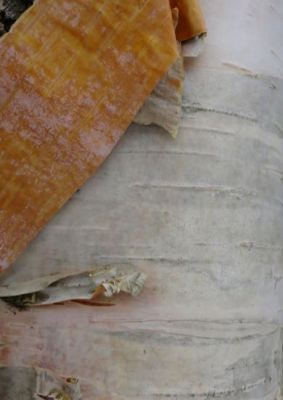A Limit of Birch

I headed into the boreal bush, across the river from the old deer shack, to hunt ruffed grouse and snowshoe hare. However, it wasn’t long before my intentions were hijacked by the parade of birch trees. I was intrigued with the array of complexions found on these white trees.
Saplings aspire to the snowy glow of their bark only after a few years of wearing a skin of brown red stippled with lenticels of white dashes. Peer closely into these thin, corky stripes and you are looking into the passage where the tireless exchange of gases pass each other.
In a handful of years the birch changes color and settles into its white finery. This is when the tree earns its genus name, Betula. In Latin, Betula means “to shine.”
As the tree grows beneath the bark, the outer layers expand and the tree literally outgrows its skin. As the tree ages the bark loses elasticity and easily cracks, splits and falls away.

Every November, during my deer shack stay, I pick up fallen shards of birch bark and bring them home to refill my stash of tinder to light the morning fire. Dry or soaking wet, the birch bark will pull a match flame towards itself and offer the promise of a fire like few other materials.
Several years ago, I shot a heavy buck that ended up in the water down river from the shack. I waded into the cold river to float the deer to a manageable place where I could pull it out and field dress it. As usual, I kept the heart and liver, but that year I carefully removed the full stomach as well. I emptied its contents and thoroughly rinsed the stomach in the river before tucking it in a plastic bag.
Back home, I turned the stomach inside out and stretched it over a small whorl of white pine branches and let it dry. The thousands of hairlike cilia that lined the inner stomach gave it a texture similar to fleece.
The stomach vessel dried tight over the struts of the pine branch. That vessel hangs on the wall near the stove and it is filled with curls and scraps of birch bark.

Sadly, many of the mature birch in northeastern Minnesota are dying. Driving northeast up the shore of Lake Superior en route to the shack, we passed many stands of dead and dying birch.
According to Welby Smith, botanist and author of Trees and Shrubs of Minnesota, “As many as 20% of all paper birches in Minnesota, in all age classes, may have died from drought related causes between 1988-89.” Since Smith’s book was published in 2008, Minnesota has experienced three of its warmest years in recorded history. Birch fare poorly in hot weather and its future as a component of the northern landscape could be in question with climate change upon us.
One tree I passed on my walk had a flag of birch bark curls while another teased me with a peek of the new latest skin exposing itself to this eleventh month. And yet others bore ragged wings of outstretched bark tatters, fluttering optimistically, as if to fledge from the forest and take flight. No matter how fast the bark flaps, deep roots solidly anchor these trees.
The candlelight glow coming from the shack was a welcome sight after my three-hour outing. While there was no heft of dead grouse or hare in my pack, I was thankful for the much lighter harvest of birch scrolls. These boreal fragments will assure me of a winter’s worth of morning fires.



